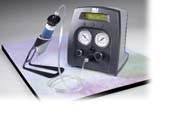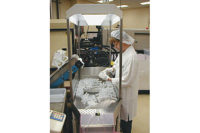
Few generic manufacturing processes are as diversely versatile as bench-top dispensing. From metering food ingredients in packaging companies to applying conductive adhesive to delicate printed circuit boards in electronics assembly facilities, today's bench-top dispensing systems offer a flexible, accurate, and cost-effective solution to a range of material-delivery issues.
Current bench-top dispensing technologies capable of delivering 80µm accuracy can be considered fit-and-forget technologies, requiring minimal training and support. However, it hasn't always been this easy. Since its birth as an industrial process in the 1950s, bench-top dispensing has undergone a push-pull evolution; it has been driven by competing technologies such as screen printing, and pulled along by users keen to stretching the operating envelope.

Origins and Development
Before discussing the technical features and benefits of current bench-top dispensing innovations in detail, it is helpful to explore the technology's origins and development.From the 1950s to the early 1960s, bench-top dispensing was launched as an industrial process. Typical manufacturing processes were set up for large-batch production with equipment that was difficult to set up or changeover. Custom products and the need for production flexibility demanded a different solution. Many of the application processes were labor intensive, and the quality and quantity of the dispensed material was operator dependent. Bench-top dispensing automated this process. Quality-conscious companies demanded a method of labor cost reduction- as well as a means of process control - to improve quality and production throughput.
Founded in 1961 by Alan Solderberg and Joe Matwick, the Techcon Systems brand business grew with the aerospace industry and government contracts. Many of the aerospace applications were small-batch or prototype projects that commanded the highest quality standards. Large, elaborate equipment, typical of the automotive industry, just wasn't feasible. Mixing by hand in a drinking cup with a craft stick and then applying with the same stick did not provide the process control or quality that the industry required. Typical dispensed materials were anaerobic, polysulfide, solvent-based adhesives and silicones.
Techcon Systems, now a brand of OK International, began as an adhesives repackaging company. To meet its own packaging needs (plus the needs of customers), the company developed the TS927 Spool Valve, which was used in its own filling process and was also sold commercially. Techcon developed the valve controllers and dispensers as well. The company quickly became known for its equipment and it started offering custom dispensing solutions for end users and private-labeled equipment for fully automated equipment.
By the late 1970s and 1980s, automated XYZ bench-top dispensing technology was emerging. Borrowing from mechanical, electrical/electronic and software developments in the rapidly growing CNC machine tool industry, new dispensing systems offered improved performance and more features, yet their size and programming overheads were still limiting factors. In essence, this generation of XYZ tables was often considered physically large, cumbersome for certain manufacturing environments and difficult to use. In addition, a trained software engineer was sometimes required to both program and operate the equipment.
Flexibility, Accuracy and Efficiency
Fast-forward to today and the picture is very different. The hallmarks of modern bench-top dispensing systems are flexibility, accuracy, efficiency and cost effectiveness. To achieve this, the three key elements of any automated XYZ bench-top dispensing system - the motion-control platform, dispensing device and material being dispensed - must be engineered to work in harmony.Focusing on the motion-control hardware, bench-top dispensing systems have continued to exploit mechanical innovations from other sectors, particularly CNC machine tools and industrial/laboratory robotics. Thanks to a combination of precision stainless-steel screw drives, servo motors and encoder-based closed-loop feedback, systems measuring just 18" x 18" are capable of moving dispensing heads at velocities of up to 20"/second.
Software innovation has followed a similar path. Twenty years ago, most automation systems relied on either mechanical or bespoke electronic/electrical control systems. Only with the advent of open PLC programming languages and industrial strength operating systems did the move to connectivity and flexibility begin. Now, owners of bench-top dispensing systems will settle for nothing less than Windows- or PLC-based programming, Gerber or CAD format file import, easy-to-use editing software, global communication of programs and data, and the ability to control all variable dispense parameters.
Safe in the knowledge that motion-control systems are now capable of delivering the speed, accuracy and repeatability required by bench-top dispensing systems, the spotlight then turns on the application system itself. This is the key to successful dispensing. Put simply, fluid-delivery systems dictate equipment limitations and accuracy. Also, as the fluid technology itself develops, accurate valves and control systems become increasingly critical.
Demanding Dispensing Parameters
Although advances in adhesive and fluid technologies have solved difficult manufacturing applications, they have also created demanding dispensing parameters. Consider the following.- Filled fluids are increasingly being used for thermal and electrical conduction
- High viscosity material can be required to prevent sag
- Moisture-, oxygen- and UV-curing mechanisms are becoming popular
- Extreme micro shot sizes are required for medical and electronics applications
- Temperature dependant viscosity
Regarding temperature dependence, viscosities can vary by up to 50% during a 5
Disposable Material Path
As a part of Techcon's TS5000 series of rotary valves, the Disposable Material Path Rotary Microvalve version features a hinged door that opens to allow access to a disposable auger that can be removed, discarded and replaced without disturbing production. Thus, when processing awkward fluids, a worn or blocked auger can now be replaced quickly and easily. Delrin augers are available in three different screw sizes (6-, 8- and 16-pitch).TS5000 series valves use an auger (rotary feed screw) to dispense fluid with a rotary-displacement action. The design ensures that fluid is constantly presented to the auger inlet, while the feed screw's controlled rotation moves the fluid to the dispensing point. This also allows dispensing of two-part materials without separation. The motor is reversible to accommodate material compressibility.
Micro Shots
Another demanding dispensing environment is the delivery of micro shots. In miniature scale applications, such as the delivery of UV adhesives during medical device manufacturing, less is often more. Capable of dispensing precise deposits down to 0.0005cm3, the TS5400 series needle valves employ a single-action pneumatic trigger that can cycle at up to 400 shots/minute.Handling a viscosity range of 1 to 100k CPS, the series' adjustable needle valves can dispense microdots of low- viscosity fluids such as solvents, inks, oils, activators and primers. With no dead fluid zone, external shot size adjustment and simple mounting options, such valves are designed to provide user-friendly solutions to precision-dispensing tasks.
The TS5000 and TS5400 valves highlight the continuous innovation driving the development of bench-top dispensing systems. However, the story does not stop there. Today's systems offer quick and easy prototype set-up, cost-effective small-batch production and quality/process control standards that meet or exceed conventional production targets. It will, therefore, come as no surprise that engineers who previously considered bench-top dispensing unsuitable for certain applications are now starting to revisit the technology with fresh eyes.
New products, such as the TS5540 spray valve, will allow for accurate and selective application of conformal and other spray coatings on a small batch scale without the need for an intricate application system. The new DX300 bench-top controller provides excellent repeatability and cycle times up to 600 cycles per minute, rivaling the speed of sophisticated production automation.
For more information, contact OK International, Techcon Systems Brand, 12151 Monarch St., Garden Grove, CA 92841; phone (714) 799-9910; fax (714) 799-9533; or visit http://www.techconsystems.com.
